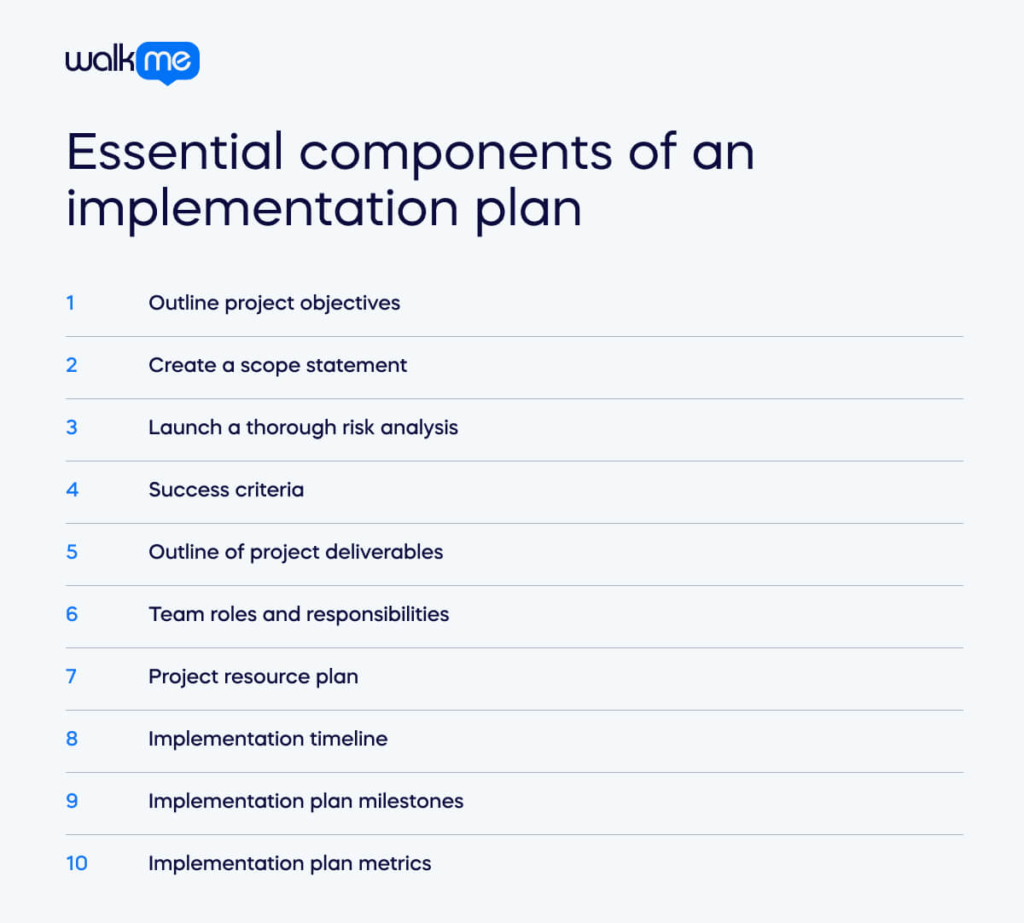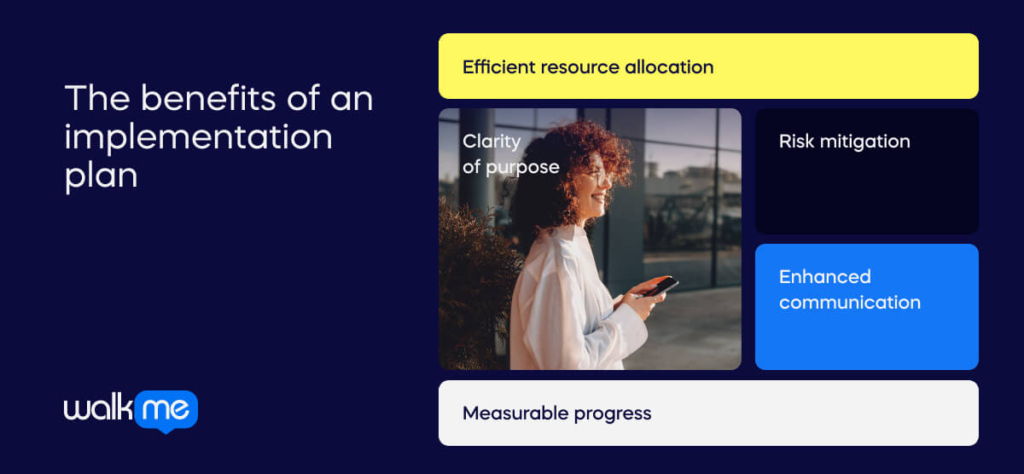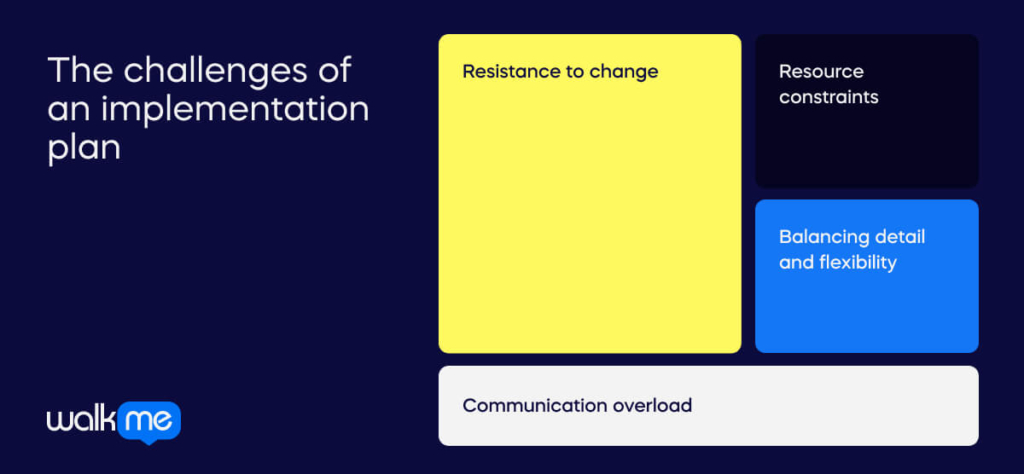An implementation plan is a formal document outlining step-by-step instructions and specific tasks required of team members to successfully achieve project goals or objectives. It’s a crucial component of project management, serving as a helpful roadmap for completing projects that support larger strategic initiatives.
Once organizational strategies have been determined, the individual actions and step-by-step process of achieving these strategic objectives necessitate introducing an implementation plan.
According to KBV Research, the global Project Management Software Market is anticipated to reach $17.75 billion by 2030. However, additional research shows that up to 80% of IT projects fail to meet their objectives and experience considerable delays or exceed planned costs.
This article explores the vital role of an implementation plan in project management, covering its definition, benefits, challenges, and essential components. It also guides readers in creating their own plans, offering key advice for successful project outcomes.
What is an implementation plan?
An implementation plan is a formal document detailing the individual steps and tangible actions project teams must take when pursuing a shared goal or objective.
The plan is a process in project management and supports an organization’s wider strategic business priorities, setting out the specific requirements and responsibilities for orchestrating successful project execution.
The plan provides project teams with a holistic view, giving them insights into a range of factors, i.e., the project’s value proposition, budgetary requirements, timeframes, potential risks, and time-to-completion.
It should encompass the end-to-end project lifecycle, enabling teams to determine the scope (the extent of what the project covers) and scale (the size or proportion of the project) while ensuring all actions are aligned with overarching strategic prerogatives.
11 Essential components of an implementation plan

Implementation plans will undoubtedly differ depending on the project’s scale, scope, perceived time-to-value driving organizational objectives, etc.
The foundation of any effective implementation plan, however, includes meeting some essential criteria, which include:
1. Outline project objectives
Before the project launch, an implementation plan should identify the project’s end goal to create a consensus on project parameters. Project leaders can refer to SMART criteria to define specific, measurable, achievable, relevant, and time-bound objectives to make up key project milestones.
Defining the project’s ultimate aim better enables teams to ensure project activities align with the organization’s wider strategic direction. To keep things on track, create a checklist that monitors the completion rate of key project goals, milestones, and other strategy-dependent factors.
2. Create a scope statement
A scope statement outlines the project’s actions and deliverables, identifies the project boundaries, and sets standards for meeting acceptance criteria.
An implementation plan should produce a structured document for stakeholder alignment. This will give them a critical reference throughout the project timeline and clearly communicate what is within and outside the project trajectory to clarify its parameters.
Scope statements help provide a clear understanding of what is expected–helping to prevent misunderstandings and ensure alignment between teams and stakeholders.
3. Launch a thorough risk analysis
Identifying potential risks and uncertainties raises awareness of any unforeseen challenges that may affect the project’s success.
Implement risk mitigation strategies such as a SWOT analysis that gives teams a robust framework for honing in on any Strengths, Weaknesses, Opportunities, and Threats that may arise throughout project execution.
Implementation plans should aim to include contingency plans that provide project teams with solutions for combatting project obstacles, i.e., missed deadlines or budget limitations, and regularly revisit and update risk management efforts as the project progresses.
4. Success criteria
Success criteria outline ideal project outcomes, identifying the milestones shaping what success means for your project.
Start by connecting these criteria to your project’s goals that turn abstract objectives into tangible accomplishments. Involve stakeholders in determining viewpoints, giving teams a well-rounded understanding of what exactly project success looks like.
Collaboratively refine these criteria, incorporating different data points to establish a comprehensive evaluation framework. Regularly reassessing and adapting the requirements as your project unfolds allows your team to navigate changing dynamics and enables a more targeted path to project success.
5. Outline of project deliverables
Project deliverables are the tangible outcomes that define project success. For example, in an implementation plan for an IT project, teams establish project deliverables through key steps. The team first figures out exactly what they want the system to do and writes it down in a detailed plan (Functional Specifications Document).
Then, they start building the system by writing the code and creating a guide on how to test it (Test Case Documentation). After testing to make sure everything works and tracking any issues, they release the final product (Live System) along with guides for users (User Manuals).
Each of these steps outlines concrete project deliverables, making it clear and organized for everyone involved.
6. Team roles and responsibilities
In crafting an implementation plan, defining team roles and responsibilities is pivotal. Start by envisioning the project landscape, identifying the key players and their distinct contributions.
Foster open communication channels to ensure a shared understanding of each team member’s role, promoting collaboration. Use clear communication tools and regular check-ins to reinforce accountability and streamline workflow.
This approach to team roles and responsibilities ensures a cohesive and efficient working environment, where each member contributes strategically to the project’s success.
7. Project resource plan
Develop a resource plan outlining the required personnel, equipment, and materials. Address resource constraints and explore alternatives. Regularly monitor and adjust the resource plan to accommodate changing project needs.
8. Implementation timeline
Create a detailed timeline outlining key milestones and activities. Use project management software to visualize dependencies and critical paths. Regularly update and communicate the timeline to keep all stakeholders informed.
9. Implementation plan milestones
Establish significant milestones to mark key achievements throughout the implementation process. Celebrate these milestones to boost team morale and maintain momentum. Ensure milestones are well-defined and aligned with project objectives.
10. Implementation plan metrics
Identify and establish key metrics to measure the success of the implementation plan. Regularly track and analyze these metrics to gauge progress and identify areas for improvement. Adjust the plan as needed based on metric insights.
What are the benefits of an implementation plan?

Implementing a robust implementation plan in project management can be a game-changer, offering a range of benefits. A clear roadmap for streamlined processes and enhanced resource efficiency brings plentiful advantages.
Let’s explore further:
Clarity of purpose
Implementation plans provide a clear roadmap, offering a tangible structure for project teams to follow. This clarity of purpose aligns everyone involved with the project’s overarching goals and objectives.
Efficient resource allocation
A well-crafted implementation plan helps efficiently allocate resources, be it human, financial, or technological. This optimization ensures that resources are utilized judiciously, preventing unnecessary bottlenecks.
Risk mitigation
One of the primary advantages of an implementation plan is its ability to identify potential risks and challenges early. This foresight enables teams to develop effective risk mitigation strategies, minimizing the impact of unforeseen obstacles.
Enhanced communication
Implementation plans establish a foundation for effective communication. Team members, stakeholders, and management are kept informed about project milestones, progress, and potential hurdles, fostering a collaborative work environment.
Measurable progress
Breaking down the project into milestones with defined deadlines allows for measuring progress. This keeps the project on track and provides stakeholders with a tangible sense of achievement.
What are the challenges of an implementation plan?

While the plan provides structure and guidance, adaptability and responsiveness to evolving circumstances are equally critical for navigating the dynamic landscape of project execution.
Finding balance in the implementation process is important for realizing the full potential of a well-crafted plan. This will mean identifying and understanding several challenges that may arise during project implementation.
Let’s explore further:
Resistance to change
Team members often resist implementing a new plan because they have become accustomed to existing processes. Overcoming this resistance requires effective change management strategies and clear communication about the benefits of the new plan.
Resource constraints
Despite meticulous planning, resource constraints may arise, leading to potential delays. This challenge requires ongoing monitoring and flexibility to adjust the plan as needed.
Balancing detail and flexibility
Striking the right balance between a detailed plan and the flexibility to adapt is challenging. Too much rigidity can stifle creativity and problem-solving, while excessive flexibility may lead to a lack of accountability.
Communication overload
While effective communication is a benefit, an overload of information can lead to confusion. Finding the right cadence and channels for communication is essential to prevent information fatigue.
How to create an implementation plan

The implementation plan drives a project forward in project management, fusing strategic blueprints and plans into concrete results.
Project leaders must follow a structured approach encompassing several key steps to navigate this crucial stage successfully.
Define project goals
A clear articulation of project goals is at the heart of any successful implementation plan. Often aligned with broader organizational objectives, these goals act as the guiding lights that inform subsequent decisions and actions. Defining these goals with precision not only provides a sense of direction, but also facilitates the establishment of measurable success criteria.
Conduct research
A thorough understanding of the project’s landscape is essential for effective implementation. Research involves delving into industry best practices, analyzing market trends, and evaluating similar projects. This information enriches decision-making and enables teams to expect challenges and devise adaptive strategies.
Define project outcomes and deliverables
Building on the foundation of project goals, the next step involves clearly defining the outcomes and deliverables expected from the implementation. These tangible markers serve as benchmarks for success and guide the team’s efforts toward producing measurable and impactful results.
Identify potential risks and challenges
In any project, uncertainties and obstacles are inevitable. Identifying potential risks and challenges allows project managers to develop risk mitigation strategies. This proactive approach empowers teams to navigate unforeseen hurdles with agility, ensuring the project stays on course.
Set project milestones and deadlines
Breaking down the implementation process into manageable milestones is essential for tracking progress and maintaining momentum. Establishing deadlines for each milestone creates a sense of urgency and accountability, fostering a structured and time-bound approach to project execution.
Assign team roles and responsibilities
Successful implementation hinges on the collaboration and coordination of a well-structured team. Assigning clear roles and responsibilities ensures that each team member understands their contribution to the project. This clarity minimizes confusion, optimizes workflow, and enhances overall efficiency.
Determine resources needed
Resource allocation is a critical aspect of implementation planning. This step involves identifying and securing the human, financial, and technological resources required for successful project execution. Adequate resource planning prevents bottlenecks and delays, ensuring a smoother implementation process.
Acquire management and stakeholder buy-In
Securing the support and buy-in of key stakeholders and upper management is fundamental to the success of any project. Communicating the value proposition, addressing concerns, and aligning expectations fosters a collaborative environment that enhances the likelihood of success.
Ensuring swift project management in the digital transformation era
Implementation plans are indispensable roadmaps in project management, gaining heightened significance in our technology-driven era.
Beyond basic guidance, they are pivotal in optimizing resource usage, addressing risks, and facilitating seamless communication. Their importance lies in their ability to provide a detailed and well-coordinated approach, guiding businesses through the intricacies of digital transformation with precision.
Implementation plans emerge as essential tools, ensuring projects align with objectives and successfully navigate the challenges posed by technological advancements.
As organizations strive to stay ahead in this dynamic environment, the strategic nature of these plans becomes increasingly evident, offering a structured path for effective project execution amidst the complexities of technological evolution.


